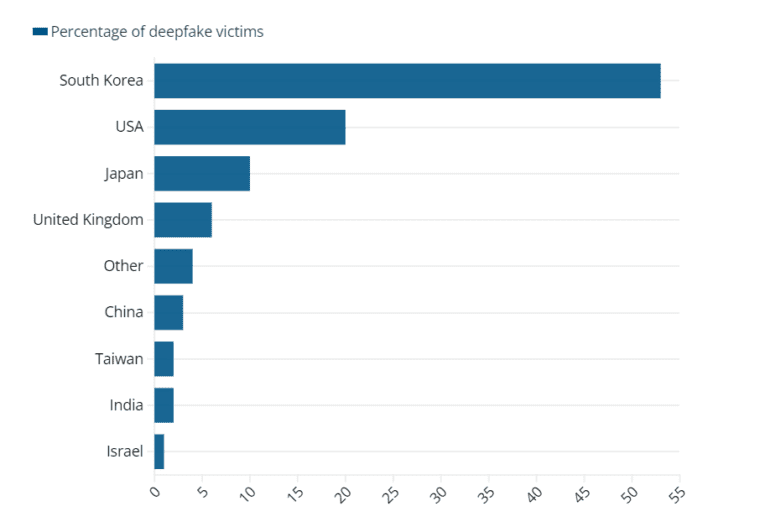TL;DR:
- Deepfake pornography dominates online content, showing a 550% increase in 2023 compared to 2019.
- Generative AI is fueling this surge, enabling hyper-realistic fake content.
- Victims describe deepfakes as life-ruining, leading to blackmail and manipulation.
- A report finds 98% of deepfakes are explicit, with 99% of victims being women.
- South Korea is hardest hit due to K-pop idol popularity and strict regulations.
- Major porn websites host deepfake content, amassing 303 million views.
- Accessible tools and online communities contribute to deepfake proliferation.
Main AI News:
The digital landscape has been engulfed by a disconcerting surge in deepfake pornography, casting a shadow over the online world. An in-depth analysis reveals an astonishing revelation: the overwhelming majority of deepfake videos encountered on the internet belong to the explicit realm. This disquieting phenomenon has experienced an alarming 550 percent upsurge in 2023 compared to the year 2019, underscoring the urgency of addressing this issue.
The exponential growth of generative artificial intelligence (AI) technologies has precipitated this troubling proliferation. These technologies have given rise to an unprecedented wave of deepfake content, characterized by its uncanny ability to fabricate digital renditions that seemingly depict genuine individuals or scenarios, spanning video, imagery, and even audio formats.
The ramifications for victims ensnared in the web of deepfake pornography are nothing short of harrowing. Their likenesses are thrust into fictitious narratives, wreaking havoc on their lives, with one survivor aptly describing it as “a lifelong sentence.” The machinery behind these nefarious creations lies in machine learning algorithms, capable of churning out hyper-realistic content that can be exploited by malevolent actors for extortion, manipulation, or criminal agendas.
A comprehensive report delving into the deepfake landscape of 2023 reveals that an alarming 98 percent of all deepfake videos circulating online belong to the explicit domain. Equally distressing is the fact that 99 percent of the victims targeted by these sordid deepfake productions are women. A team of analysts from the vigilant guardians of online identity, homesecurityheroes.com, embarked on a meticulous study, examining a staggering 95,820 deepfake videos, scrutinizing 85 dedicated online channels, and dissecting over 100 websites intertwined within the deepfake ecosystem. Their findings have culminated in the revealing “2023 State of Deepfakes” report.
A stark revelation emerges from this report: it now takes a mere 25 minutes, at zero cost, to craft a one-minute-long deepfake pornographic video, employing just a single clear image of the victim’s face. The majority of these deplorable creations, according to the study, predominantly feature South Korean women. Following South Korea, the United States, Japan, and the United Kingdom find themselves among the nationalities most afflicted by this digital contagion.
The Deepfake Pandemic in South Korea
South Korea stands out as the epicenter of this deepfake pandemic, a phenomenon attributed to the global popularity of K-pop. Notably, three of the four members of Blackpink, revered as South Korea’s premier girl pop ensemble, rank among the top 10 individuals most frequently targeted. Chris Nguyen, Head of Research Analysis for the report, elucidates, “K-pop idols are renowned for their widespread visibility and devoted fanbase, both domestically and internationally.” This elevated prominence and dedicated following make K-pop idols prime subjects for the creation and dissemination of deepfake pornography, with the potential to reach a vast audience.
In addition to their high visibility, there exists an “exceptionally high” demand for content featuring K-pop idols, fueling the production of explicit deepfake material, particularly on specialized adult websites. This calculated exploitation seeks to capture attention and boost website traffic. Furthermore, South Korea’s stringent regulations on pornography likely inadvertently stimulate the creation and distribution of such content, a classic example of the “Streisand effect,” where attempts to conceal or censor information paradoxically amplify its visibility and interest.
The Proliferation of Deepfake Content on the Web
When examining the prevalence of deepfake pornography, analysts uncovered a disconcerting revelation: seven out of the top ten most-visited adult websites host deepfake content. Across these top ten dedicated deepfake pornography websites, an astounding 303 million video views have been recorded. This data underscores the alarming proliferation and popularity of such content.
A pressing need arises for open dialogues surrounding societal attitudes toward this burgeoning phenomenon, with a particular focus on the ethical quandaries it raises. Researchers attribute the sudden surge in deepfake content to two key factors. Firstly, the emergence of generative adversarial networks (GANs) as a machine learning framework has bestowed the technical prowess to create deepfake content. Secondly, the ready accessibility of GAN-based tools empowers nearly anyone to rapidly and inexpensively generate deepfake content.
“These platforms offer a range of features, from simple face swapping to more complex video manipulations,” explains the report, shedding light on the rapid evolution of online communities dedicated to deepfake creation, fostering collaboration, knowledge exchange, and the development of open-source projects. The fight against deepfake pornography demands a concerted effort, transcending boundaries and upholding ethical standards in the digital age.
Conclusion:
The proliferation of deepfake pornography poses a severe ethical and societal concern. With its widespread prevalence and ease of creation, addressing this issue is paramount. Businesses and policymakers must prioritize technologies and regulations that combat the spread of malicious deepfake content to protect individuals and maintain trust in digital spaces.

